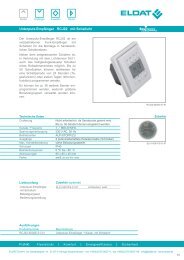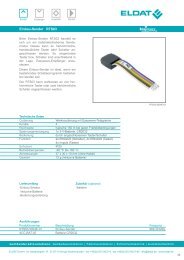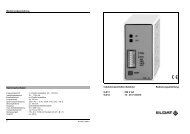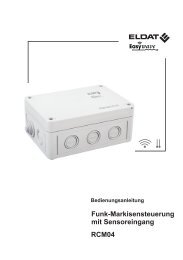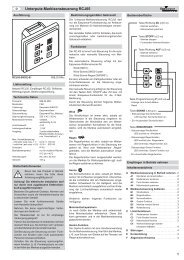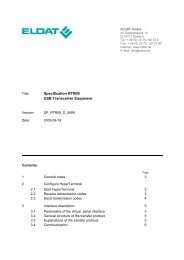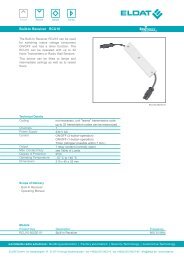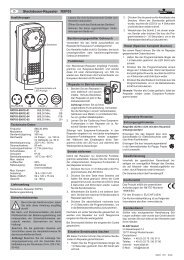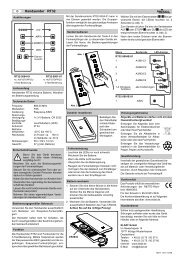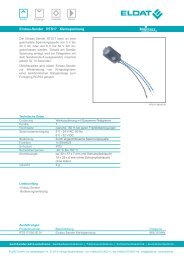Specification of RTRM08 Transceiver Module Easywave I2C - ELDAT
Specification of RTRM08 Transceiver Module Easywave I2C - ELDAT
Specification of RTRM08 Transceiver Module Easywave I2C - ELDAT
You also want an ePaper? Increase the reach of your titles
YUMPU automatically turns print PDFs into web optimized ePapers that Google loves.
<strong>Specification</strong><br />
Index 1.01<br />
Project No.<br />
RF-Products, Controller <strong>RTRM08</strong> <strong>Transceiver</strong> <strong>Module</strong> Easw I 2 C Page 20<br />
Development<br />
Production S. Schreiber 2007-08-24<br />
7007<br />
and RX_USERDATA1 registers contain the opaque user data which is associated with the channel<br />
number.<br />
• The module does not receive further valid learned <strong>Easywave</strong> telegrams. The RX_TEL_VALID-bit<br />
in the RX_STATUS register is set to 0 now; it indicates the end <strong>of</strong> a learned <strong>Easywave</strong> telegram.<br />
(For example, the user has released the button <strong>of</strong> a transmitter.)<br />
• The I 2 C master can read out the channel number, the button number, and the opaque user data if the<br />
RX_TEL_VALID-bit in the RX_STATUS register is 1.<br />
While the RX_TEL_CHANGED bit is 1, the transceiver module won't change the contents <strong>of</strong> the<br />
RX_CHANNEL and RX_BUTTON registers and <strong>of</strong> the RX_TEL_VALID bit in the RX_STATUS register even if<br />
another <strong>Easywave</strong> telegram is received.<br />
• If the I 2 C master reads the RX_ACK register, the transceiver module drops the channel number and the<br />
button number <strong>of</strong> the received telegram. The RX_ACK register also can be read in a single read transfer<br />
with the other registers mentioned above. If one <strong>of</strong> the above conditions has occurred meanwhile, the<br />
/ REQ output remains low, and the RX_TEL_CHANGED-bit in the RX_STATUS register remains 1. Otherwise<br />
the transceiver module clears the RX_TEL_CHANGED-bit in the RX_STATUS register and the / REQ output<br />
goes high. (For example, a user holds down the button <strong>of</strong> a transmitter or the user does not push any<br />
button.) If the / REQ output goes high, the transceiver module guarantees that it happens before the I 2 C<br />
read transfer from the RX_ACK register on the I 2 C-bus terminates.<br />
The green LED blinks as long as the transceiver module receives any <strong>Easywave</strong> telegram. (The LED is<br />
drawn on Figure 1 on page 4).<br />
transceiver<br />
/REQ<br />
output<br />
RX_TEL_-<br />
CHANGED<br />
RX_TEL_-<br />
VALID<br />
I 2 C-bus<br />
high<br />
low<br />
1<br />
0<br />
1<br />
0<br />
RX<br />
on<br />
receive<br />
telegrams #1<br />
read<br />
data:<br />
begin<br />
telegr.<br />
#1<br />
RX<br />
on<br />
read<br />
data:<br />
end <strong>of</strong><br />
telegr.<br />
Figure 11 Sequence when receiving <strong>Easywave</strong> telegrams<br />
receive<br />
telegrams #2<br />
read<br />
data:<br />
begin<br />
telegr.<br />
#2<br />
receive<br />
telegrams #3<br />
read<br />
data:<br />
begin<br />
telegr.<br />
#3<br />
RX<br />
on<br />
read<br />
data:<br />
end <strong>of</strong><br />
telegr.<br />
A master should perfom the following steps if it wants to receive <strong>Easywave</strong> telegrams subsequent it has set<br />
the RX_MODE-register to the RX_RQ or RX_PL value:<br />
• Wait until the / REQ output goes low (RX_RQ only) or wait until the RX_TEL_CHANGED-bit in the



